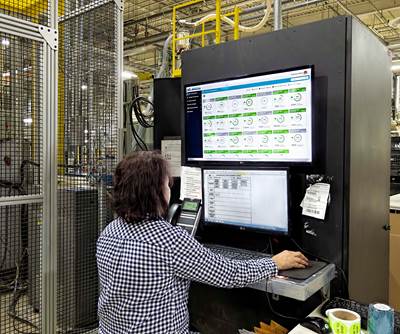INJECTION MOLDING: How to Mold Living Hinges With No Flexing Required
Here are the five critical, intertwined components that must be perfected for a living hinge that doesn’t need to be flexed upon ejection.
One the advantages plastics have over other materials is the ability to mold them into living hinges. Living-hinge applications vary from common flip-top lids like caps and floss boxes to not-so-common yet clever medical devices like hemostats (photo). While the range of applications varies, the rules to mold them do not.
I bet that the problems most processors have with molding living hinges can be traced to their treating molding as more art than science. Since my career has been focused on making molding closer to a science, let’s lay down the rules for making hinges that take multiple flexes without tearing, breaking apart, or otherwise fouling your day on the production floor. Further, our goal is to produce hinges that are molded without flexing upon ejection.
Living hinges are a great example of why you must follow the strategy of legendary plastics designer Glenn Beall for a successful application. Each of his five key components requires special attention in making functional hinges. And with living hinges, the interaction between these components is highly intertwined. The components are:
1. Piece part design;
2. Resin selection and handling;
3. Mold design and construction;
4. Processing;
5. Testing.
You need to get these five ducks in a row—along with their “chicks” (sub-components). If you think you can skip any one of them, you’re asking for trouble. Serious attention to each component is required. It can get you out of the common production issue of flexing the hinge immediately after ejection. While flexing can help, the practice is unnecessary if each of the components (ducks and chicks) are lined up. In other words, you are wasting production time and losing money by flexing living hinges. The problem is that many molders just want to get the mold built and begin running parts and don’t like to fuss with the details. Let’s review each component and see whether they are lined up.
PART DESIGN
Several design articles covering living hinges are available. Two must-reads were authored by Beall (short.ptonline.com/beall) and Proto Labs (short.ptonline.com/proto) No sense in repeating what the masters have written. Print the pages and laminate them—you’ll be referring to them often. Proper design of the hinge is critical if you want a truly functional living hinge.
RESIN SELECTION
Homopolymer PP is often recommended as the first material choice for living hinges; but fellow Plastics Technology columnist Mike Sepe disagrees, and I’ll defer to his expert opinion. Sepe recommends a PP random copolymer or lightly modified block copolymer. Generally, the higher the toughness, the better. Watch for blush (stress whitening) as the hinge is flexed. Higher molecular weights and low melt-flow rates will work better, but are harder to push into the mold.
In addition, you are aiming for low nucleation and proper molecular orientation. Nucleation rate is resin and process dependent. Molecular orientation is processing and mold (gate location) dependent.
Color and the color carrier are also significant issues. Test all colors and colorant carriers after thermal cycling the part to make sure hinge performance is acceptable before you begin production. Run natural and compare results with all colors. If you see problems, talk to your colorant supplier. It is well worth the extra money to have them formulate all colors so they perform and process similarly.
Different colors change the degree of crystallization. You need the same low degree of crystallinity. Good color houses can adjust the nucleation to provide more uniform crystallinity across your colors. It is common in molding plants to see one or two colors that consistently cause problems. That means low production rates, wasted man and machine hours, poor performance, and lost profits. Pay for the proper colorant.
Polypropylene is not the only resin choice, as nylon and polyethylene can also be used. As always in plastics, many applications are unique with special considerations. Check with your resin supplier, but make sure you are not getting only what that supplier has to offer.
MOLD DESIGN AND CONSTRUCTION
There are myriad details within each of these components, and mold design is no exception. Gate location is a feature that is non-negotiable. You certainly do not want a weld line near the hinge area. Promoting a symmetrical flow-front formation through the hinge is of utmost importance. The gate must ensure flow perpendicular to the hinge to optimize molecular orientation across the hinge.
Mold-fill simulation is the best means to determine your ability to fill, where weld lines develop, and where you should locate critically needed vents. It is very important to refine mesh-element size and configuration in the hinge area of the simulation model to capture true pressure loss. Make sure the gate is located so that when the flow front reaches the hinge area, pressure can be generated to drive the flow through the hinge with no hesitation (i.e., while another section of the part fills). Achieving proper molecular orientation across the hinge is critical, and therefore so is consistent flow across the hinge.
In addition, placing ribs and bosses “post-hinge” (as the material flows into the cavity) is a bad idea if you want to mold sink-free parts. The hinge freezes off before the gate, so packing a section after the hinge will be difficult.
Another aspect of mold construction is cooling, especially in the hinge area. This is critical to good-quality hinges (with no flexing) and to prolonged hinge life. Typically, this area needs to have a parallel water circuit running as close as possible to the hinge. This will minimize crystalline development and promote hinge life and strength.
PROCESSING
Melt quality is critical, so avoid general-purpose (or “no-purpose”) screws. A 20:1 L/D is the minimum length, and the screw should be designed to deliver melt uniformity with no mixer. Shot size should be less than 60% of the barrel capacity to ensure a good-quality melt. Set screw rotation speed to take up most of the cooling time for screw recovery.
You have to start with uniformly melted plastic. Remember that PP, PE, and nylon are semi-crystalline materials and thus are more difficult to melt than amorphous resins and take twice as many BTU/lb to melt.
The pressure loss driving the plastic through the hinge’s nominal wall of about 0.008 in. will be substantial. Make sure your machine is not pressure limited. Your machine should have at least 30,000 psi available to be able to handle a wide range of hinge applications. In addition, fill at a high velocity.
Once again, if you want a good living hinge, the molecules should be oriented perpendicularly across the hinge, not parallel to it. Slow filling or any hesitation as the material hits the hinge area will result in weak hinges that tear easily and/or work for only few cycles. Keep in mind that faster fill speeds also demand excellent venting, and vacuum venting may be needed.
To confirm that you have an appropriate flow pattern to develop proper molecular orientation across the hinge, do a short-shot study, from full part to short, noting the pattern in which the hinge area fills. It must be symmetrical, with no hesitation, and at a fast velocity to orient the molecules perpendicular to the hinge. Packing out the area beyond the hinge is often difficult due the thin nominal wall of the hinge freezing quickly, often before the gate freezes.
Cooling is 95% of your cycle and perhaps the most critical element of keeping the molecular orientation across the hinge. It’s critical that the hinge area be cooled rapidly to minimize crystallization. This hinge portion of the mold must be cooled rapidly, requiring low water temperatures of about 15 C (60 F).
TESTING
As always, thermal cycle the part and test for number of cycles and stress whitening. Check for degradation via Mike Sepe’s recommended melt-flow study of pellets vs. parts. You want no more than a 30-40% change (see Materials Know-How, Dec. ’13). Test all colors.
Living hinges provide great applications but they are complicated. All five elements are intertwined, one influences the other. You have to find the ducks and get them lined up. This takes time and effort to go through the five key components of making a successful plastics application. Spending the time up front before production yields fewer hassles and higher profits. It’s your choice: Pay now or pay (more) later.
ABOUT THE AUTHOR
John Bozzelli is the founder of Injection Molding Solutions (Scientific Molding) in Midland, Mich., a provider of training and consulting services to injection molders, including LIMS, and other specialties. E-mail john@scientificmolding.com or visit scientificmolding.com.
Related Content
Use These 7 Parameters to Unravel the Melt Temperature Mystery
Despite its integral role in a stable process and consistent parts, true melt temperature in injection molding can be an enigma. Learning more about these seven parameters may help you solve the puzzle.
Read MoreOnline Versions of Process Development Course and Software Launch
NPE2024: FimmTech is introducing online versions of its Nautilus process development software as well as its Scientific Molding and Design of Experiments (DOE) process development course.
Read MoreRead Next
Lead the Conversation, Change the Conversation
Coverage of single-use plastics can be both misleading and demoralizing. Here are 10 tips for changing the perception of the plastics industry at your company and in your community.
Read MorePeople 4.0 – How to Get Buy-In from Your Staff for Industry 4.0 Systems
Implementing a production monitoring system as the foundation of a ‘smart factory’ is about integrating people with new technology as much as it is about integrating machines and computers. Here are tips from a company that has gone through the process.
Read MoreSee Recyclers Close the Loop on Trade Show Production Scrap at NPE2024
A collaboration between show organizer PLASTICS, recycler CPR and size reduction experts WEIMA and Conair recovered and recycled all production scrap at NPE2024.
Read More
.jpg;width=70;height=70;mode=crop)



















